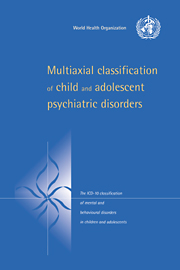 Multiaxial Classification of Child and Adolescent Psychiatric Disorders
Multiaxial Classification of Child and Adolescent Psychiatric Disorders Published online by Cambridge University Press: 05 November 2011
This axis contains a list of conditions in other chapters of ICD-10 that are often found in association with the disorders in Chapter V(F) itself. They are provided here so that psychiatrists recording diagnoses by means of the Clinical Descriptions and Diagnostic Guidelines have immediately to hand the ICD terms and codes that cover the associated diagnoses most likely to be encountered in ordinary clinical practice. The majority of the conditions covered are given only at the three-character level, but four-character codes are given for a selection of those diagnoses that are likely to be used most frequently. A dash following a three character code (e.g. A80.–) indicates that the full ICD-10 includes categories at the four character level but that these are not included in this abbreviated list. This dash is not inserted where at least one four character rubric has been included under the respective three digit one, even if not all the four character ones are cited. Those wishing to use the four character code where only three are cited in this list, will need to consult the full ICD-10.
As with the first three axes, a coding of XX should be given when there is no significant medical condition.
Chapter I
Certain infectious and parasitic diseases (A00–B99)
Congenital syphilis
A50.0 Early congenital syphilis, symptomatic
A50.1 Early congenital syphilis, latent
A50.2 Early congenital syphilis, unspecified
A50.3 Late congenital syphilitic oculopathy
A50.4 Late congenital neurosyphilis [juvenile neurosyphilis]
A50.5 Other late congenital syphilis, symptomatic
A50.6 Late congenital syphilis, latent
A50.7 Late congenital syphilis, unspecified
A50.9 Congenital syphilis, unspecified
Acute poliomyelitis
Slow virus infections of central nervous system
A81.1 Subacute sclerosing panencephalitis
A81.2 Progressive multifocal leukoencephalopathy
To save this book to your Kindle, first ensure no-reply@cambridge.org is added to your Approved Personal Document E-mail List under your Personal Document Settings on the Manage Your Content and Devices page of your Amazon account. Then enter the ‘name’ part of your Kindle email address below. Find out more about saving to your Kindle.
Note you can select to save to either the @free.kindle.com or @kindle.com variations. ‘@free.kindle.com’ emails are free but can only be saved to your device when it is connected to wi-fi. ‘@kindle.com’ emails can be delivered even when you are not connected to wi-fi, but note that service fees apply.
Find out more about the Kindle Personal Document Service.
To save content items to your account, please confirm that you agree to abide by our usage policies. If this is the first time you use this feature, you will be asked to authorise Cambridge Core to connect with your account. Find out more about saving content to Dropbox.
To save content items to your account, please confirm that you agree to abide by our usage policies. If this is the first time you use this feature, you will be asked to authorise Cambridge Core to connect with your account. Find out more about saving content to Google Drive.